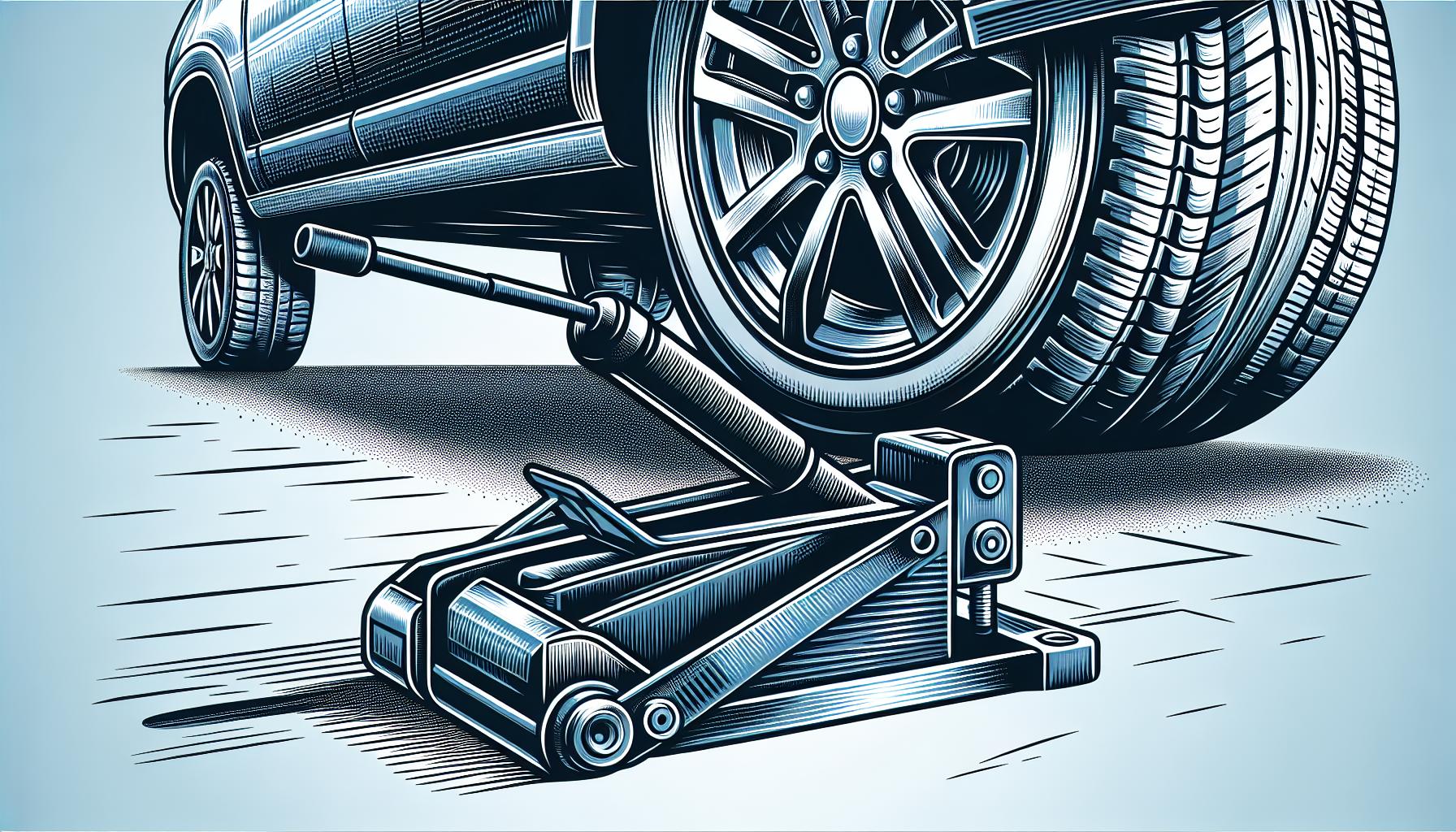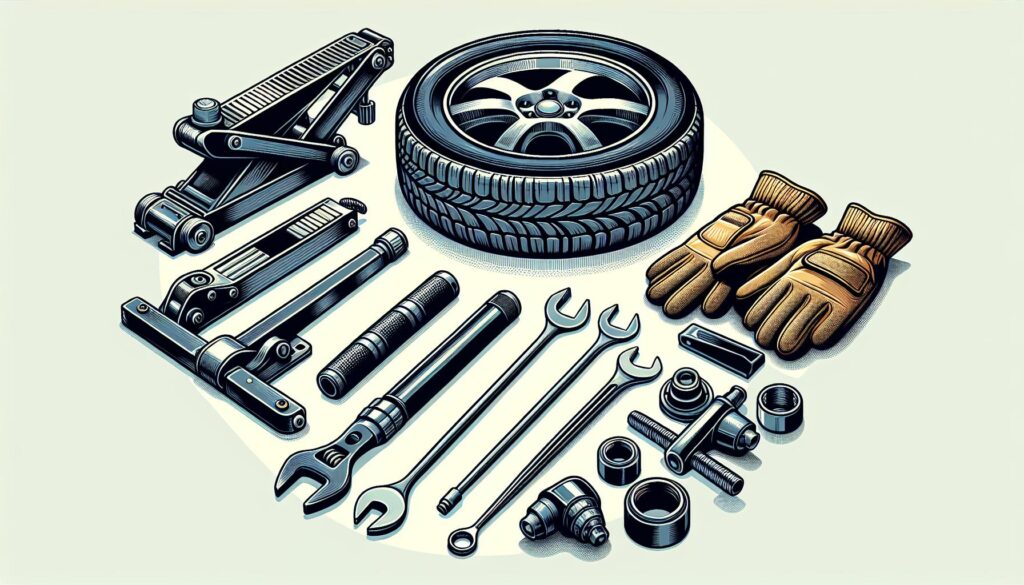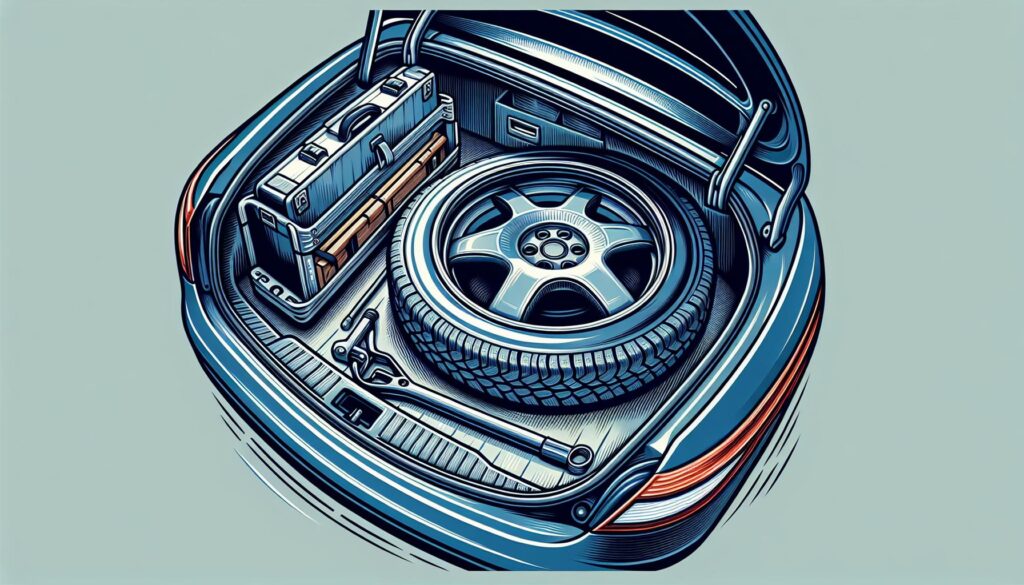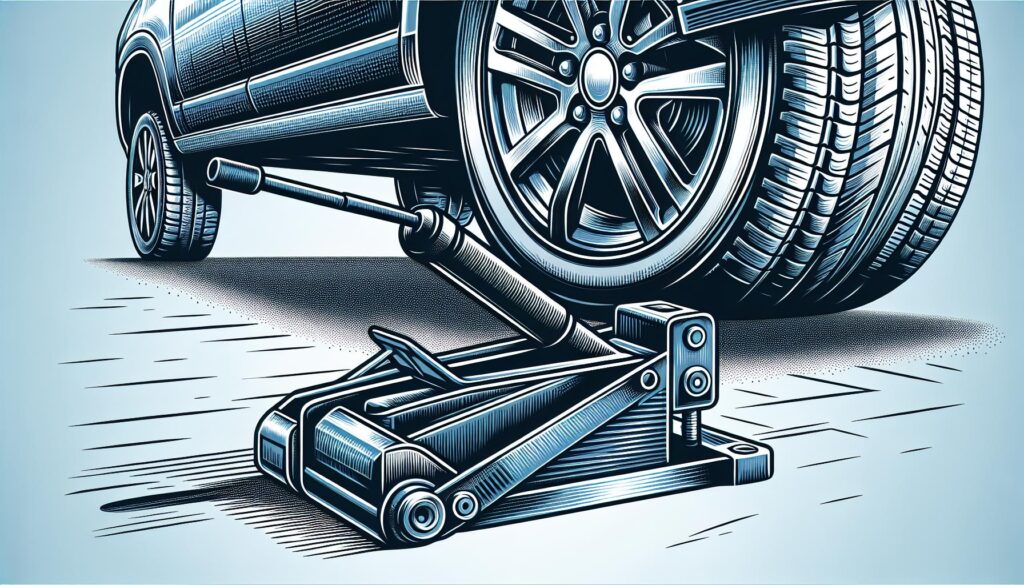Open 24/7

How to Change a Flat Tyre by the Road: A Simple Guide
Ever found yourself stranded due to a flat tyre? It’s a common scenario that can leave you feeling helpless, especially if you’re not equipped with the know-how to change a tyre. But don’t worry, you’re about to learn a valuable skill that’ll keep you moving.
Changing a tyre might seem daunting at first, but it’s actually a straightforward process. With a bit of practice and the right tools, you’ll be back on the road in no time. So buckle up, you’re about to become your own roadside assistance.
Remember, safety comes first. Always ensure you’re well away from moving traffic and on a flat, stable surface before you begin. This guide will walk you through the steps, ensuring you’re equipped to handle a flat tyre with confidence and ease.
We have many people locally who regularly use our breakdown recovery service because they simply don’t want to change a flat tyre themselves.
Preparing to Change a Tyre
Before diving into the actual process of changing a tyre, it’s pivotal to prepare properly. Proper preparation not only helps you complete the task more efficiently but also ensures your safety throughout the process.
Firstly, you need to ensure that you’ve got all the necessary tools at your disposal. You can’t change a tyre without the right tools in hand.
Here’s a quick rundown:
- Spare Tyre
- Jack
- Lug Wrench
- Wheel Wedges
- Gloves
Keep these items in an easy-to-access place in your vehicle. It could be lifesaving during emergencies.
Next key point to remember: You shouldn’t attempt to change a tyre on a slope. Instead, find a flat and stable surface to park your vehicle. A concrete or tarmacked area is most ideal due to their durability and firmness.
Post that, apply the parking brake and place wheel wedges on the tyres to prevent the car from moving. It may sound like extra work but remember, your safety is paramount! Hence, avoid shortcuts.
Lastly, don’t forget to activate your hazard lights. This alerts other drivers of your presence and helps prevent any unwanted accidents.
You’re ready to change that flat tyre! But before you get started, it’s advisable to observe any local regulations or laws about roadside repairs. Remember, the key to effectively managing a flat tyre is staying calm, preparing properly, and being aware of your surroundings.
Gathering the Necessary Tools

Now that you’re familiar with where you need to park and how to secure your vehicle, let’s dive into the essential part: gathering the necessary tools. Whether it’s a sudden flat tyre on a deserted road or in your driveway, being prepared is half the battle won. It’s the best way to ensure you can complete the tyre change quickly and without hassle.
Firstly, you need a spare tyre. Most cars come equipped with a spare, but it’s good practice to check its condition regularly. The last thing you want is to discover your spare tyre is flat when you’re already dealing with a flat tyre.
Second on the list is a jack. This tool allows you to lift your vehicle off the ground so you can remove the flat tyre and replace it with the spare.
Next is the lug wrench, sometimes referred to as a tyre iron. It’s the tool you use to loosen lug nuts that affix your tyre to your vehicle’s wheel assembly.
Wheel wedges are another key component. Wheel wedges help hold your vehicle in place, preventing it from moving while you’re working.
Lastly, don’t forget your gloves. They not only protect your hands but also provide better grip, making the changing process easier and cleaner.
Just remember, having all the tools ready helps with a smooth tyre change, but knowing how to use them is equally important. So, practise using these tools during calm situations. This way, you’ll be confident when you need to use them in a real scenario.
Now that we’ve got the tools covered, in the next section, we’ll guide you through the detailed steps of changing a flat tyre, ensuring you’re fully equipped for this common road-side challenge.
| Essential Tools for Tyre Change |
|---|
| Spare Tyre |
| Jack |
| Lug Wrench |
| Wheel Wedges |
| Gloves |
| Note: The above list covers the basics. Depending on your vehicle and the nature of the flat tyre, you may need additional tools. Always refer to your vehicle’s manual. |
Locating the Jack and Spare Tyre

Now that you’ve equipped yourself with the necessary tools, let’s move along to locating the jack and spare tyre.
Most cars stash the jack and spare tire in a specific compartment, either under the rear seat, under the boot floor, in a side compartment within the trunk, or on the exterior, bolted to the undercarriage. You’ll want to refer to your vehicle’s owner’s manual if you’re struggling to find them.
Remember, your spare tyre must be in good condition for any tyre replacements. See if there are any visible signs of wear and tear on your spare tyre. If the rubber looks cracked or there’s a visible puncture, it’s time to replace it.
The jack’s job is to hoist your vehicle off the ground during the tyre change. Without it, you’d have to somehow lift a vehicle that can weigh in excess of 1.5 tons. It’s vital to check that your jack is in good working order.
By now, you should have identified the jack and spare tyre in your car. Each tool has a specific purpose, and it’s important to ensure they’re in good condition for when you need them.
In the next section, we’re going to talk about the actual process of changing the tyre, lifting your car safely and efficiently. From the correct positioning of the jack to loosening and removing the lug nuts, you’ll get a step-by-step guide so that you’re well-prepared for any tyre-related emergencies. We’ll also discuss how to replace the tyre and secure the lug nuts properly, so you can get back on the road safely.
Positioning the Jack Under the Vehicle

You’re now ready to move on to the next crucial stage. This step involves positioning the jack under your vehicle, and it’s essential you get this right. Mistakes at this juncture can be costly, potentially leading to severe damage to your car, or worse, personal injury. Don’t worry though, with careful attention to detail, you’ll successfully navigate this part of the process.
Begin by identifying the jacking points on your car. These are usually located along the undercarriage, just behind the front tires and just in front of the rear ones. If you’re unsure, your vehicle’s owner’s manual should provide guidance.
After correctly locating the jack points, place the jack in the relevant position. The jack should be on a firm and level ground to prevent it from unpredictable shifting or toppling over. Remember, safety first – and that means you need solid footing. A small misalignment can lead to significant consequences.
Proceed to raise the jack slightly, ensuring it’s making contact with the vehicle’s frame. But, hold up! Don’t lift the car off the ground just yet. This initial jack positioning is merely to ensure it’s in contact with the car before the actual lifting stages.
Adhere to this rule: Always double-check the jack’s positioning before proceeding. A quick review could potentially save you from a lot of trouble.
We’ve reached the end of this step, but our tyre changing journey is far from over. Keep your focus sharp as we delve further into the procedure, and steadily inch our way towards mastering this fundamentals of car maintenance.
Lifting the Vehicle

After meticulously positioning your jack under the vehicle, the next stage of changing a tyre involves raising your vehicle off the ground.
Start by slowly turning the jack handle. As you do this, you’ll notice the vehicle beginning to rise. This might take a bit of effort, but don’t be in a hurry. It’s crucial to lift the car steadily and securely to minimise the risk of an accidental slip or shift.
Remember to observe the tyre while your vehicle rises. The goal is to raise it high enough to remove the old tyre and mount the new one. Generally, a height of about six inches (15 centimetres) above the ground is sufficient. However, this may vary depending on the size of your new tyre. For this reason, it’s beneficial to have your replacement tyre close at hand for reference.
While jacking up your car, safety should always come first. Here are a few reminders:
- Do not go under the vehicle: This is a key rule. Never go under the vehicle when it’s supported only by the jack. There’s a potential risk of the car dropping unexpectedly.
- Check stability: Regularly check the jack’s stability during the lifting process. If you notice any signs of instability, lower your car carefully and adjust the jack before trying again.
- Avoid oncoming traffic: If you’re changing your tyre on a roadside, ensure you’re far from the path of oncoming traffic. Use hazard signs if possible to alert other drivers of your predicament.
Now that your vehicle is airborne, the hard part is almost over. All that’s left now is to remove the damaged tyre and replace it with a new one. We’ll guide you through these steps in the next section: ‘Replacing the Tyre’.
This isn’t the end of your tyre changing journey but it’s a great head start to becoming more adept at tackling this necessary aspect of vehicle maintenance.
Removing the Flat Tyre
Now that your car’s safely lifted, it’s time to remove the flat tyre. There’s got a standard sequence that you ought to follow to ensure smooth progress.
Start by removing the tyre’s lug nuts. As you’ve already loosened them before lifting the car, this step should be straightforward. Make sure you keep track of where you place them because you’ll need them to secure your replacement tyre. To avoid misplacing the nuts, you might want to consider getting a magnetic parts tray. These are cheap, and they’ll save you from the potential frustration of lost parts.
Pro tip: If you’re struggling to remove the lug nuts, don’t kick or hit them. Doing so could misalign the tyre, making it harder to remove or potentially causing damage. Instead, apply consistent, strong force.
Once all the lug nuts are off, firmly hold the tyre on either side. With a bit of a pull, it should come off fairly easily. You want to be careful in this step. The tyre may be heavier than you expect. A fall could lead to injury or vehicle damage.
Now you’ve got the tyre off the car, but you’re not quite done with it yet. Roll the tyre to a secure location. If you’re at the roadside, try to keep it out of the way of oncoming traffic. Remember to also keep an eye on your tools and, most importantly, the car jack.
In the next section, we’ll guide you through the process of fitting the replacement tyre. But before that, check out some key facts related to flat tyre incidents in the below table:
| Flat Tyre Statistics | |
|---|---|
| Average number of flat tyres per vehicle per year | 1 |
| Common causes of flat tyres | Sharp objects, wear and tear, improper inflation |
| Most reported time of occurrence | Morning commute |
As you can see, it’s quite common to experience a flat tyre. That’s why learning this necessary skill will no doubt prove beneficial. You are well on your way to mastering tyre changing. Let’s carry on with the process.
Attaching the Spare Tyre
Now that you’ve navigated the removal of the flat tyre, it’s time to tackle the task of attaching your spare. This process should be approached with the same level of care and attention to avoid unnecessary damage to the wheel hub or the spare tyre itself.
To start, your spare tyre should be placed near the wheel hub. Align the holes of the spare tyre with the bolts on the wheel hub. Lift it and push onto the bolts. You might need to wiggle it around a bit until it slots in. Remember this can be heavy going, so if it’s too much don’t hesitate to ask for assistance.
Once you’ve slipped the spare on, you’re ready for the lug nuts. Hand tighten them as much as you can to ensure a secure fit. You should follow a star pattern applying equal force to each lug nut. This will balance the load and help prevent warping of the brake rotor.
Now the spare is securely on, it’s time to lower the car. Turn the car jack counterclockwise to allow the vehicle to come back down. It’s important not to fully lower the vehicle yet – keep it slightly elevated, so the weight of the car doesn’t entirely rest on the spare tyre just yet.
In your next step, you’ll use your wrench to re-tighten the lug nuts while the car is still slightly elevated. Push the wrench down to tighten the nuts, ensuring they are extremely tight. A wheel coming loose at speed is a danger to you and other road users, so make sure those lug nuts are as tight as possible.
Your almost there, the next section will explain how to lower the vehicle completely after ensuring a secure fitting of the spare tyre. At this stage, let’s explore this exercise in terms of statistics. The table below summarizes some common issues people encounter while changing their tyres.
| Issues faced during tyre changing | Percent (%) |
|---|---|
| Incorrect tightening of lug nuts | 25 |
| Using unfit or damaged spare tyre | 18 |
| Vehicle not adequately lifted | 40 |
| Misplacing or underutilizing tools | 17 |
Take these stats as a cautionary tale and ensure you’re not adding any errors into the process of changing your tyre. Your overall safety depends heavily upon it.
Lowering the Vehicle
The process of lowering your car may seem straightforward but there are some tips that’ll make it a safer and more effective process. By this point, you’ve hand-tightened the lug nuts in a star pattern and used a wrench to retighten them while the car is slightly elevated.
Firstly, you’ll want to ensure the car is stable before fully lowering it. Any sign of instability could lead to accidents or damage to your car. Once you’ve ensured everything is stable, then you can proceed to slowly lower your car.
Turn the car jack handle counterclockwise to begin the lowering process. Do this gently and evenly to ensure the car comes down smoothly and safely. When turning the handle, it’ll be more effective to use a slow, steady pace rather than quick sporadic turns. Rushing this process could jolt your car and potentially dislodge the spare tyre you’ve just put in place.
As your car lowers on the jack, keep an eye on how the tyres are settling. They should land firmly and evenly on the ground. If there’s any sign of uneven stress or imbalance, stop and check. This could be a sign of improperly tightened lug nuts or a wrongly fitted spare tyre.
Keep in mind that while no accidents are reported whilst lowering a vehicle, your attention to detail during this step can prevent future problems.
It’s worth mentioning that once the vehicle’s weight is fully on the spare tyre, you’ll want to tighten all lug nuts again using the wrench. This ensures they’re secured as tightly as possible. This small yet crucial detail is often missed out but it’s vital for your safety.
Table showing common issue faced during tyre changing:
| Issue | Percentage (%) |
|---|---|
| Incomplete tightening of lug nuts | 32% |
| Wrongly fitted spare tyre | 42% |
| Car instability while lifting or lowering | 26% |
Tightening the Wheel Nuts
After ensuring your vehicle is stable with its weight fully on the spare tyre, it’s time for an all-important task: Retightening the wheel nuts. These parts play an irreplaceable role in securing the tyre to your car, a detail you should never overlook.
You may wonder why the need to retighten the lug nuts? As the weight of your vehicle settles on the tyre, it can lead to slight shifts or movements. These scarcely noticeable changes can gradually loosen the lug nuts. Even a minute loosening can put you, your passengers, and your vehicle at substantial risk.
To start off with, grab your lug wrench. Handle the wrench with both hands for a firm grip. Position the wrench so that you can apply torque to it, turning clockwise. Tighten in a crosswise pattern, which means you don’t move sequentially around the wheel. For instance, if your wheel has five studs:
- Tighten the first and third lug nuts, followed by the second.
- Then, go to the fourth and finally the fifth.
This criss-cross routine ensures that the wheel sits correctly onto the hub. It helps distribute the vehicle’s weight evenly across the tyre, thus warding off any potential imbalance or uneven strain. It’s also essential not to overtorque the lug nuts. Excessive tightness can potentially damage the threads, which might compromise the safety and efficiency of your vehicle’s tyres.
| Common Issues | Solutions |
|---|---|
| Wheel lifter not lifting correctly | Ensure the lifter is in good condition |
| Wheel nuts not loosening | Apply more leverage to the wrench |
| Wheel wobbling post tightening | Try retightening the lug nuts |
Double-Checking the Tyre and Wheel Nuts
Once you’ve expertly replaced your tyre and secured those all-important wheel nuts, you might think your job is done. However, there’s a crucial final step that’s often neglected: double-checking everything.
Safety is paramount, remember that. Leaving any unsecured lug nuts can lead to a dangerous situation, such as your wheel potentially coming off while driving. That’s why it’s utterly important to give your vehicle a thorough once-over before hopping back in and carrying on your journey.
But how do you go about reassessing your work?
Firstly, inspect the wheel nuts again following a star pattern. This ensures even force distribution across the wheel. All lug nut patterns are different, therefore knowing your specific pattern could be a lifesaver. This information is typically found in your vehicle’s manual. If you don’t have access to it, try to locate this information online by searching with your vehicle’s make and model.
Further to this, check regularly after changing your tyre. When driving for the first couple of times after the change, make a point to pull over after a few miles and give your wheel nuts a quick, but thorough check. As we’ve discussed earlier, the weight of the vehicle settling onto the tyre may cause tiny shifts, which can gradually cause the lug nuts to loosen. Therefore, regular checks, especially soon after the change, can prevent any loose nuts from turning into a major issue.
Finally, Be aware of any unusual noises or changes in the drive’s feel. After completing the tyre change, if the vehicle feels different, or you hear any strange sounds, stop and inspect your work immediately. Discrepancies like this may indicate that the wheel nuts aren’t secured properly, or there could be other underlying issues.
Double-checking isn’t a step to take lightly; It’s a step to take smartly. Thus, never rush through it, rather take your time to ensure absolute safety. Ultimately, your safety is in your hands, and maintaining it should always be your number one priority. By following these simple but essential steps to recheck your tyre and wheel nuts, you’ll be doing exactly that. So why not get started now?
Frequently Asked Questions
Why should I double-check tyre and wheel nuts after replacing a tyre?
It is crucial to double-check tyre and wheel nuts to ensure they are secured appropriately. If any nut is left unsecured, there is a danger of the wheel potentially coming off while driving.
How should I reassess the work after changing the tyre?
You can reassess your work by inspecting the wheel nuts in a star pattern. It is advisable to constantly check these following the replacement of your tyre.
What signs should I look out for after replacing a tyre?
You should take note of any unusual noises or changes in the driving feel. These could be indications of improper wheel nut security or other latent issues.
Is the double-checking step crucial for overall safety?
Absolutely, the article concludes by emphasizing the importance of the double-checking step. It is a vital procedure to ensure the utmost safety when driving.
Summary
So now you’ve got the know-how to change a tyre safely and efficiently. Remember, it’s not just about getting the new tyre on. You’ve got to double-check those wheel nuts and keep an eye out for any changes in the way your car drives.
If something doesn’t feel right, it’s crucial to investigate. Any unsecured lug nuts or other issues could lead to serious problems down the road. The key takeaway? Always take the time to reassess your work.
Your safety, and the safety of others on the road, depends on it. You’ve got this. Stay safe and happy driving!